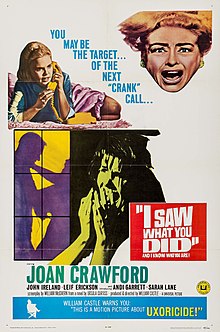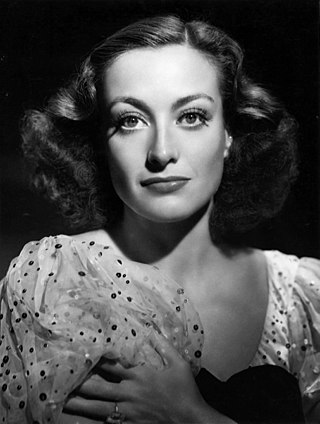
Joan Crawford was an American actress. She started her career as a dancer in traveling theatrical companies before debuting on Broadway. Crawford was signed to a motion picture contract by Metro-Goldwyn-Mayer in 1925. Initially frustrated by the size and quality of her parts, Crawford launched a publicity campaign and built an image as a nationally known flapper by the end of the 1920s. By the 1930s, Crawford's fame rivaled MGM colleagues Norma Shearer and Greta Garbo. Crawford often played hardworking young women who find romance and financial success. These "rags-to-riches" stories were well received by Depression-era audiences and were popular with women. Crawford became one of Hollywood's most prominent movie stars and one of the highest paid women in the United States, but her films began losing money. By the end of the 1930s, she was labeled "box office poison".

Ruth Elizabeth "Bette" Davis was an American actress of film, television, and theater. Regarded as one of the greatest actresses in Hollywood history, she was noted for her willingness to play unsympathetic, sardonic characters and was known for her performances in a range of film genres, from contemporary crime melodramas to historical and period films and occasional comedies, although her greatest successes were her roles in romantic dramas. She won the Academy Award for Best Actress twice, was the first person to accrue ten Academy Award nominations for acting, and was the first woman to receive a Lifetime Achievement Award from the American Film Institute. In 1999, Davis was placed second on the American Film Institute's list of the greatest female stars of classic Hollywood cinema.

Mommie Dearest is a memoir and exposé written by Christina Crawford, the adopted daughter of Academy Award winning actress Joan Crawford. Published in 1978, it attracted much controversy for its portrayal of Joan Crawford as a cruel, unbalanced, and alcoholic mother, with Crawford's other twin daughters, household staff, and family friends denouncing it as sensationalized fiction. It was turned into a 1981 film of the same title starring Faye Dunaway.

Elda Furry, known professionally as Hedda Hopper, was an American gossip columnist and actress. At the height of her influence in the 1940s, over 35 million people read her columns.

Trog is a 1970 British science fiction horror film directed by Freddie Francis and starring Joan Crawford, Michael Gough and Bernard Kay. The screenplay was by Peter Bryan, John Gilling and Aben Kandel.

House on Haunted Hill is a 1959 American horror film produced and directed by William Castle, written by Robb White and starring Vincent Price, Carol Ohmart, Richard Long, Alan Marshal, Carolyn Craig and Elisha Cook Jr. Price plays an eccentric millionaire, Frederick Loren, who, along with his wife Annabelle, has invited five people to the house for a "haunted house" party. Whoever stays in the house for one night will earn $10,000. As the night progresses, the guests are trapped within the house with an assortment of terrors. This film is perhaps best known for its promotional gimmick Emergo.
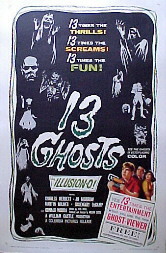
13 Ghosts is a 1960 American supernatural horror film produced and directed by William Castle, written by Robb White and starring Rosemary DeCamp, Margaret Hamilton, Charles Herbert, Martin Milner, Jo Morrow, John van Dreelen, and Donald Woods.

William Castle was an American film director, producer, screenwriter, and actor.
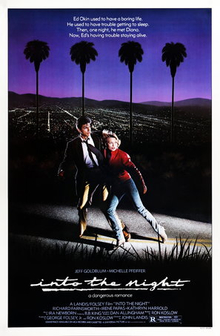
Into the Night is a 1985 American black comedy action thriller film directed by John Landis, starring Jeff Goldblum and Michelle Pfeiffer. The film focuses on an insomniac aerospace engineer (Goldblum), who is approached by a jewel smuggler (Pfeiffer) whose life is in danger, on the run from several international foes.

Mommie Dearest is a 1981 American biographical psychological drama film directed by Frank Perry and starring Faye Dunaway, Steve Forrest, Mara Hobel, and Diana Scarwid, with supporting performances from Xander Berkeley in his feature film debut along with Rutanya Alda and Jocelyn Brando. Adapted from Christina Crawford's 1978 autobiography of the same name, the film follows her and her brother Christopher's upbringing under their adoptive mother, actress Joan Crawford, depicting her as abusive, controlling, and manipulative, prioritizing her Hollywood career over her family.
The Plame affair was a political scandal that revolved around journalist Robert Novak's public identification of Valerie Plame as a covert Central Intelligence Agency officer in 2003.

The Tingler is a 1959 American horror film produced and directed by William Castle. It is the third of five collaborations between Castle and writer Robb White, and starring Vincent Price.

Homicidal is a 1961 American horror-thriller film produced and directed by William Castle, and starring Glenn Corbett, Patricia Breslin, Eugenie Leontovich, Alan Bunce and Jean Arless. The film follows a murderous woman in a small California town whose presence unearths secrets concerning a prominent local family.
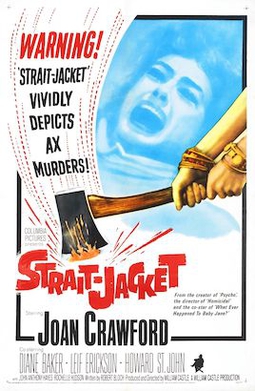
Strait-Jacket is a 1964 American psychological horror film directed and produced by William Castle, written by Robert Bloch and starring Joan Crawford. Its plot follows a woman who, having murdered her husband and his lover decades prior, is suspected of a series of axe murders following her release from a psychiatric hospital.
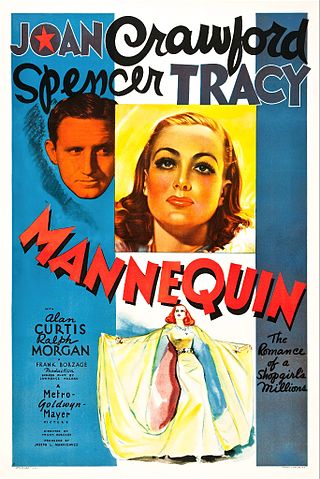
Mannequin is a 1937 American drama film directed by Frank Borzage and starring Joan Crawford, Spencer Tracy, and Alan Curtis. Crawford plays Jessie, a young working class woman who seeks to improve her life by marrying her boyfriend, only to find out that he is no better than what she left behind. She meets a self-made millionaire with whom she falls in love despite his financial problems.

Female on the Beach is a 1955 American crime-drama film directed by Joseph Pevney starring Joan Crawford and Jeff Chandler in a story about a wealthy widow and her beach bum lover. The screenplay by Robert Hill and Richard Alan Simmons was based on the play The Besieged Heart by Robert Hill. The film was produced by Albert Zugsmith.

Daniel "Dan" Fitzgerald is a fictional character from the Australian soap opera Neighbours, played by Brett Tucker. He made his first screen appearance during the episode broadcast on 1 September 1999. Dan becomes a teacher at Erinsborough High and shares a house with fellow teacher, Tess Bell. He remained as a recurring character until 2000. Tucker returned on 30 October 2007 and became part of the regular cast. Dan re-joined the high school and he began a relationship with Libby Kennedy. In June 2009, it was announced that Tucker had quit the show and Dan departed on 1 December 2009. On 13 September 2010, Dan made a one-off appearance which was filmed prior to Tucker's departure in 2009. The character later appeared in a flashback broadcast on 4 July 2011, played by James Roach.
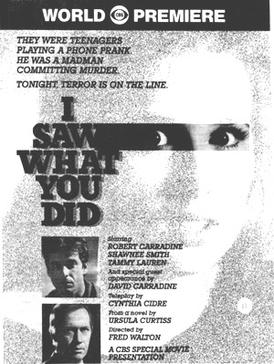
I Saw What You Did is a 1988 American made-for-television horror film directed by Fred Walton, with a screenplay by Cynthia Cidre. It is a remake of the 1965 theatrical film of the same name starring Joan Crawford, and the second adaptation of Out of the Dark by Ursula Curtiss. The film stars Shawnee Smith and Tammy Lauren as teenage friends Kim Fielding and Lisa Harris, respectively, and Candace Cameron as Kim's younger sister Julie; opposite them is Robert Carradine as the mentally disturbed Adrian Lancer, and David Carradine as his brother Stephen. While making prank phone calls pretending to know who the other person is, and what they've done, Kim and Lisa call Adrian, who has recently murdered his girlfriend, causing him to set out to find them.

Big Driver is a 2014 American crime thriller television film based on the novella of the same name by Stephen King, published in his collection Full Dark, No Stars (2010). It was directed by Mikael Salomon and written by Richard Christian Matheson.
